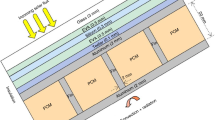Abstract
With the improvement of computational speed, thermal management becomes a serious concern in computer system. CPU chips are squeezing into tighter and tighter spaces with no more room for heat to escape. Total power-dissipation levels now reside about 110 W, and peak power densities are reaching 400–500 W/mm2 and are still steadily climbing. As a result, higher performance and greater reliability are extremely tough to attain. But since the standard conduction and forced-air convection techniques no longer be able to provide adequate cooling for sophisticated electronic systems, new solutions are being looked into liquid cooling, thermoelectric cooling, heat pipes, and vapor chambers. In this paper, we investigated a novel method to significantly lower the chip temperature using liquid metal with low melting point as the cooling fluid. The liquid gallium was particularly adopted to test the feasibility of this cooling approach, due to its low melting point at 29.7 °C, high thermal conductivity and heat capacity. A series of experiments with different flow rates and heat dissipation rates were performed. The cooling capacity and reliability of the liquid metal were compared with that of the water-cooling and very attractive results were obtained. Finally, a general criterion was introduced to evaluate the cooling performance difference between the liquid metal cooling and the water-cooling. The results indicate that the temperature of the computer chip can be significantly reduced with the increasing flow rate of liquid gallium, which suggests that an even higher power dissipation density can be achieved with a large flow of liquid gallium and large area of heat dissipation. The concept discussed in this paper is expected to provide a powerful cooling strategy for the notebook PC, desktop PC and large computer. It can also be extended to more wide area involved with thermal management on high heat generation rate.
Zusammenfassung
Die Steigerungen der Rechengeschwindigkeiten in modernen Computersystemen in Verbindung mit einer stetigen Erhöhung der Leistungsdichte führt dazu, dass eine effektive Abführung der in Form von Wärme freigewordenen Energie zu einer zentralen Aufgabe geworden ist. Inzwischen beträgt die in CPUs dissipierte Energie 110 W bei Wärmestromdichten von 400–500 W/mm2. Die bisher eingesetzten Kühlungsverfahren sind hierfür nicht geeignet, so dass neue Prozesslösungen erforderlich sind. In dieser Arbeit wird ein neues Verfahren vorgestellt, bei dem flüssiges Metall mit einer niedrigen Schmelztemperatur eingesetzt wird, um die Temperatur leistungsstarker Chips signifikant abzusenken. Als Flüssiges Kühlmittel wird Gallium eingesetzt, das eine Schmelztemperatur von 29.7 °C und hohe Werte der thermischen Leitfähigkeit und der Wärmekapazität aufweist. Messungen wurden mit unterschiedlichen Mengenströmen und Energiedissipationsraten ausgeführt und mit den Ergebnissen für wassergekühlte Systeme verglichen. Das vorgestellte Konzept kann sehr wirkungsvoll für unterschiedlichste, leistungsstarke Rechnersysteme eingesetzt werden.
Similar content being viewed by others

References
Strassberg D (1994) Cooling hot microprocessors. END 39(2):7
Lundquist C, Carey VP (2001) Microprocessor-based adaptive thermal control for an air-cooled computer CPU module. In: Annual IEEE Semiconductor Thermal Measurement and Management Symposium, San Jose, pp 168–173
Semeniouk V, Fleurial JP (1997) Novel high performance thermoelectric microcoolers with diamond substrates. In: Proceedings of the 1997 16th International Conference on Thermoelectrics, Dresden, 1997, pp 683–686
DiSalvo FJ (1999) Thermoelectric colling and power generation. Science 285:703–706
Simons RE, Chu RC (2000) Application of thermoelectric cooling to electronic equipment: a review and analysis. In: Annual IEEE Semiconductor Thermal Measurement and Management Symposium, San Jose, pp 1–9
Xie H, Ali A, Bhatia R(1998) Use of heat pipes in personal computers. Thermomechanical Phenomena in Electronic Systems. In: Proceedings of the Intersociety Conference, Seattle, pp 442–448
Nquyen T, Mochizuki M, Mashiko K, Saito Y, Sauciuc L (2000) Use of heat pipe/heat sink for thermal management of high performance CPUS. In: Annual IEEE Semiconductor Thermal Measurement and Management Symposium, San Jose, pp 76–79
Lv YG, Zhou YX, Liu J (2006) Experimental validation of a conceptual vapor-based air-conditioning system for the reduction of chip temperature through environmental cooling in a computer closet. J Basic Sci Eng, preliminarily accepted
Liu J, Zhou YX (2002) A computer chip cooling method which uses low melting point metal and its alloys as the cooling fluid. China Patent No. 02131419.5
Smither RK, Lee W, Macrander A, Mills D, Rogers S (1992) Recent experiments with liquid gallium cooling of crystal diffraction optics. Rev Sci Instrum 63(2):1746–1754
Smither RK, Forster GA, Kot CA, Kuzay TM (1988) Liquid gallium metal cooling for optical elements with high heat loads. Nucl Instrum Methods Phys Res A 266:517–524
Sawada T, Netchaev A, Ninokata H, Endo H (2000) Gallium-cooled liquid metallic-fueled fast reactor. Prog Nucl 37:313–319
Qian ZY (1985) Thermal properties of low melting point metal. Science Press, Beijing
Prokhorenko VY, Roshchupkin VV, Pokrasin MA, Prokhorenko SV, Kotov VV (2000) Liquid gallium: potential uses as a heat-transfer agent. High Temp 38:954–968
Tagawa T, Ozoe H (1998) Enhanced heat transfer rate measured for natural convection in liquid gallium in a cubical enclosure under a static magnetic field. J Heat Transf Trans ASME 120:1027–1032
Eckert ERG, Drake RM (1971) Analysis of heat and mass transfer. McGraw-Hill, New York
Lyon RN (1951) Liquid metal heat-transfer coefficients. Chem Eng Prog 47:75–79
Gu XM, Gong YX, Zang XW, Tang KL, Lv YY, Zeng WZ (1990) Inorganic Chemistry Series (2). Science Press, Beijing
Compile group of rare metal information (1990) Scattered metals. Metallurgical Industry Press, Beijing
Author information
Authors and Affiliations
Corresponding author
Rights and permissions
About this article
Cite this article
Li, T., Lv, YG., Liu, J. et al. A powerful way of cooling computer chip using liquid metal with low melting point as the cooling fluid . Forsch Ingenieurwes 70, 243–251 (2005). https://doi.org/10.1007/s10010-006-0037-1
Received:
Published:
Issue Date:
DOI: https://doi.org/10.1007/s10010-006-0037-1



